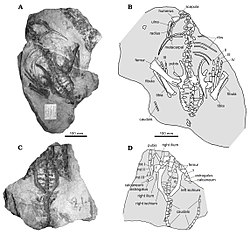Stenopelix
| Stenopelix Temporal range: Late Berriasian, ~
| |
|---|---|

| |
| Latex casts of the holotype slabs and interpretive drawings | |
| Scientific classification | |
| Kingdom: | Animalia |
| Phylum: | Chordata |
| Clade: | Dinosauria |
| Order: | †Ornithischia |
| Suborder: | †Ceratopsia |
| Genus: | †Stenopelix Meyer, 1857 |
| Species: | †S. valdensis
|
| Binomial name | |
| †Stenopelix valdensis Meyer, 1857
| |
Stenopelix (meaning "narrow pelvis") is a genus of small marginocephalian dinosaur, possibly a basal ceratopsian, from the Early Cretaceous of Germany. It lived in the late Berriasian Stage of the Cretaceous period, approximately 140 myr ago.[1] The genus is based on a partial skeleton lacking the skull, and its classification is based on characteristics of the hips.
Discovery and species[]

In 1855, in a sandstone quarry near Bückeburg on the Harrl, a fossil was found of a small dinosaur. Most of its bones were in a poor condition and removed on preparation, leaving two sets of hollow impressions on the plate and counterplate. The two plates do not overlap completely. The hollows, serving as a natural mold, have since been used to produce several casts in gypsum and latex to facilitate the study of the specimen. It was originally part of the collection of preserved in the Bückeburg [2] but was in 1976 moved to the Georg-August-Universität Göttingen where it now resides in the collection of the .
In 1857, based on this fossil, Christian Erich Hermann von Meyer named the type species Stenopelix valdensis.[3] The generic name is derived from Greek stenos, "narrow", and pelyx, "pelvis". The specific name refers to the Wealden Formation. The holotype, GZG 741/2 (earlier GPI 741-1, 2), found in the Obernkirchen Sandstein Formation, consists of the impressions of an almost complete skeleton, lacking the skull and the neck.
Classification[]

The classification of Stenopelix is controversial and has ever been problematic because of the lacking skull. Prior to the 1960s, it was often assigned to some ornithopod group. In 1974 Teresa Maryańska suggested it to be a pachycephalosaur, one of the oldest known, due to the apparent exclusion of the pubis from the acetabulum, and the presence of strong caudal ribs. Peter Galton in 1982 showed that the "pubis" was actually part of the acetabulum, and the so-called "caudal ribs" were sacral ribs. The curvature of the ischium and absence of an obturator foramen were not characteristics seen in other pachycephalosaurs. Galton concluded Stenopelix to be ceratopian.[4]
However, exact cladistic analyses by Paul Sereno have resulted in a position in the Pachycephalosauria. But paleontologists Richard J. Butler and Robert M. Sullivan nonetheless view the species as being Marginocephalia incertae sedis, rejecting the presumed synapomorphies with the Pachycephalosauria as incorrect identifications or lacking cogency because of a possible presence in ceratopsian groups.[5] In 2011, a cladistic analysis performed by Butler et al. showed that Stenopelix is a basal member of the Ceratopsia, and its sister taxon is Yinlong.[6]
Paleobiology[]
Stenopelix was a small herbivorous animal. The preserved rump and tail have a combined length of just 97 centimetres; the femur is fourteen centimetres long. The species can be distinguished by several details of the pelvis. The shaft part of the ilium uniformly tapers ending in a rounded point. The shaft of the ischium is thickest in the middle and there shows a distinctive kink.
See also[]
References[]
- ^ Holtz, Thomas R. Jr. (2011) Dinosaurs: The Most Complete, Up-to-Date Encyclopedia for Dinosaur Lovers of All Ages, Winter 2010 Appendix.
- ^ *Hermann Schmidt, 1969, "Stenopelix valdensis H. v. Meyer, der kleine Dinosaurier des norddeutschen Wealden", Paläontologische Zeitschrift 43(3/4): 194-198
- ^ *Meyer, H. von, 1857, "Beiträge zur näheren Kenntis fossiler Reptilien", Neues Jahrbuch für Mineralogie, Geologie und Paläontologie 1857: 532–543
- ^ *H.-D. Sues and P. M. Galton, 1982, "The systematic position of Stenopelix valdensis (Reptilia: Ornithischia) from the Wealden of north-western Germany", Palaeontographica Abteilung A 178(4-6): 183-190
- ^ *R. J. Butler and R. M. Sullivan, 2009, "The phylogenetic position of Stenopelix valdensis from the Lower Cretaceous of Germany and the early fossil record of Pachycephalosauria", Acta Palaeontologica Polonica 54(1): 21-34
- ^ Richard J. Butler; Jin Liyong; Chen Jun; Pascal Godefroit (2011). "The postcranial osteology and phylogenetic position of the small ornithischian dinosaur Changchunsaurus parvus from the Quantou Formation (Cretaceous: Aptian–Cenomanian) of Jilin Province, north-eastern China". Palaeontology. 54 (3): 667–683. doi:10.1111/j.1475-4983.2011.01046.x.
External links[]
- Ceratopsians
- Marginocephalians
- Berriasian life
- Early Cretaceous dinosaurs of Europe
- Cretaceous Germany
- Fossils of Germany
- Fossil taxa described in 1857
- Taxa named by Christian Erich Hermann von Meyer
- Ornithischian genera




